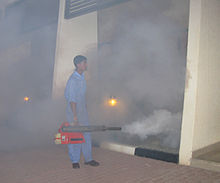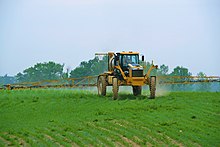Pesticide application: Difference between revisions
| Line 54: | Line 54: | ||
* [[aerial application]] |
* [[aerial application]] |
||
* [[Aerosol spray]] |
* [[Aerosol spray]] |
||
* [[Chitosan]] (Natural Biocontrol for Agricultural & Horticultural use) |
|||
* [[Pesticide formulation|Formulation]] |
* [[Pesticide formulation|Formulation]] |
||
* [[Integrated pest management]] (IPM) |
* [[Integrated pest management]] (IPM) |
||
Revision as of 13:36, 23 April 2009


Pesticide application refers to the treatment of an organism, such as a crop or ornamental plant, against damage by other plants, insects, fungi, or animals. The term pesticide, as presented here, could refer to the use of herbicides, fungicides, insecticides, or nematode control.
Seed Treatments
Pesticides can be applied to the seed prior to planting, in the form of a seed treatment, or coating, to protect against soil-borne risks to the plant; additionally, these coatings can provide supplemental chemicals and nutrients designed to encourage growth. A typical seed coating can include a nutrient layer--containing nitrogen, phosphorus, and potassium, a rhizobial layer--containing symbiotic bacteria and other beneficial microorganisms, and a fungicide (or other chemical) layer to make the seed less vulnerable to pests.[1].
Spray application
One of the more common forms of pesticide application, especially in conventional agriculture, is the use of mechanical sprayers. Hydraulic sprayers consists of a tank, a pump, a lance (for single nozzles) or boom, and a nozzle (or multiple nozzles). Sprayers convert a pesticide formulation, often containing a mixture of water (or another liquid chemical carrier, such as fertilizer) and chemical, into droplets, which can be large rain-type drops or tiny almost-invisible particles. This conversion is accomplished by forcing the spray mixture through a spray nozzle under pressure. The size of droplets can be altered through the use of different nozzle sizes, or by altering the pressure under which it is forced, or a combination of both. Large droplets have the advantage of being less susceptible to spray drift, but require more water per unit of land covered. Small droplets are able to static electricity to maximize contact with a target organism, but require very still wind conditions.
Spraying Pre- and Post-emergent Crops


Traditional agricultural crop pesticides can either be applied pre-emergent or post-emergent, a term referring to the germination status of the plant. Pre-emergent pesticide application, in conventional agriculture, attempts to reduce competitive pressure on newly germinated plants by removing undesirable organisms and maximizing the amount of water, soil nutrients, and sunlight available for the crop. An example of pre-emergent pesticide application is atrazine application for corn. Similarly, glyphosate mixtures are often applied pre-emergent on agricultural fields to remove early-germinating weeds and prepare for subsequent crops. Pre-emergent application equipment often has large, wide tires designed to float on soft soil, minimizing both soil compaction and damage to planted (but not yet emerged) crops. A three-wheel application machine, such as the one pictured on the right, is designed so that tires do not follow the same path, minimizing the creation of ruts in the field and limiting sub-soil damage.
Post-emergent pesticide application requires the use of specific chemicals chosen minimize harm to the desirable target organism. An example is 2,4-Dichlorophenoxyacetic acid, which will injure broadleaf weeds (dicots) but leave behind grasses (monocots). Such a chemical has been used extensively on wheat crops, for example. A number of companies have also created genetically-modified organisms that are resistant to various pesticides. Examples include glyphosate-resistant soybeans and Bt maize, which change the types of formulations involved in addressing post-emergent pesticide pressure. It is important to also note that even given appropriate chemical choices, high ambient temperatures or other environmental influences, can allow the non-targeted desirable organism to be damaged during application. As plants have already germinated, post-emergent pesticide application necessitates limited field contact in order to minimize losses due to crop and soil damage. Typical industrial application equipment will utilize very tall and narrow tires and combine this with a sprayer body which can be raised and lowered depending on crop height. These sprayers usually carry the label ‘high-clearance’ as they can rise over growing crops, although usually not much more than 1 or 2 meters high. In addition, these sprayers often have very wide booms in order to minimize the number of passes required over a field, again designed to limit crop damage and maximize efficiency. In industrial agriculture, spray booms 120 feet (40 meters) wide are not uncommon, especially in prairie agriculture with large, flat fields. Related to this, aerial pesticide application is a method of top dressing a pesticide to an emerged crop which eliminates physical contact with soil and crops.
Air Blast sprayers, also known as air-assisted or mist sprayers, are often used for tall crops, such as tree fruit, where boom sprayers and aerial application would be ineffective. These types of sprayers can only be used where overspray--spray drift--is less of a concern, either through the choice of chemical which does not have undesirable effects on other desirable organisms, or by adequate buffer distance. These can be used for insects, weeds, and other pests to crops, humans, and animals.[2] Air blast sprayers inject liquid into a fast-moving stream of air, breaking down large droplets into smaller particles by introducing a small amount of liquid into a fast-moving stream of air. [3]
Foggers fulfill a similar role to mist sprayers in producing particles of very small size, but use a different method. Whereas mist sprayers create a high-speed stream of air which can travel significant distances, foggers use a piston or bellows to create a stagnant area of pesticide that is often used for enclosed areas, such as houses and animal shelters.[4]
Other application equipment
- CDA & ULV application equipment
- Granule application equipment
- Dust application
- Application methods for household insecticides
Spraying Inefficiencies
In order to better understand the cause of the spray inefficiency, it is useful to reflect on the implications of the large range of droplet sizes produced by typical (hydraulic) spray nozzles. This has long been recognized to be one of the most important concepts in spray application (e.g. Himel, 1969), bringing about enormous variations in the properties of droplets.
Historically, dose-transfer to the biological target (i.e. the pest) has been shown to be inefficient (Graham-Bryce, 1977). However, relating "ideal" deposits with biological effect is fraught with difficulty (e.g. Hislop, 1987). In spite of Hislop’s misgivings, it is relatively easy to demonstrate that massive amounts of pesticides are wasted by run-off from the crop and into the soil, in a process called endo-drift. This is a less familiar form of pesticide drift, with exo-drift causing much greater public concern. Pesticides are conventionally applied using hydraulic atomisers, either on hand-held sprayers or tractor booms, where formulations are mixed into high volumes of water.
Different droplet sizes have dramatically different dispersal characteristics, and are subject to complex macro- and micro-climatic interactions (Bache & Johnstone, 1992). Greatly simplifying these interactions in terms of droplet size and wind speed, Craymer and Boyle (1973) concluded that there are essentially three sets of conditions under which droplets move from the nozzle to the target. These are where:
- sedimentation dominates: typically larger (>100 µm) droplets applied at low wind-speeds; droplets above this size are appropriate for minimising drift contamination by herbicides.
- turbulent eddies dominate: typically small droplets (<50 µm) that are usually considered most appropriate for targeting flying insects, unless an electrostatic charge is also present that provides the necessary force to attract droplets to foliage. (NB: the latter effects only operate at very short distances, typically under 10 mm.)
- intermediate conditions where both sedimentation and drift effects are important. Most agricultural insecticide and fungicide spraying is optimised by using relatively small (say 50-150 µm) droplets in order to maximize “coverage” (droplets per unit area), but are also subject to drift.
Improved targeting
In the 1970s and 1980s improved application technologies such as controlled droplet application (CDA) received extensive research interest, but commercial uptake has been disappointing. By controlling droplet size, ultra-low volume (ULV) or very low volume (VLV) application rates of pesticidal mixtures can achieve similar (or sometimes better) biological results by improved timing and dose-transfer to the biological target (i.e. pest). No atomizer has been developed able to produce uniform (monodisperse) droplets, but rotary (spinning disc and cage) atomizers usually produce a more uniform droplet size spectrum than conventional hydraulic nozzles. Other efficient application techniques include: banding, baiting, specific granule placement, seed treatments and weed wiping.
CDA is good examples of a rational pesticide use (RPU) technology (Bateman, 2003), but unfortunately has been unfashionable with public funding bodies since the early 1990s, with many believing that all pesticide development should be the responsibility of pesticide manufacturers. On the other hand, pesticide companies are unlikely widely to promote better targeting and thus reduced pesticide sales, unless they can benefit by adding value to products in some other way. RPU contrasts dramatically with the promotion of pesticides, and many agrochemical concerns, have equally become aware that product stewardship provides better long-term profitability than high pressure salesmanship of a dwindling number of new “silver bullet” molecules. RPU may therefore provide an appropriate framework for collaboration between many of the stake-holders in crop protection.
Historical Techniques


See also
- aerial application
- Aerosol spray
- Formulation
- Integrated pest management (IPM)
- Pest control
- Pesticide
- Pesticide-drift
- sprayer
- spray nozzle
- Weed control
References
- ^ http://www.planttech.com.au/seed_coating.php/>
- ^ http://www.mistsprayers.com/
- ^ Waxman, Michael F., (1998) Application Equipment. In: “Agrochemical and Pesticide Safety Handbook Ed. M. Wilson. CRC Press, Boca Raton (ISBN 9781566702966) pp. 326.
- ^ http://www.dropdata.org/DD/sprayers.htm#Foggers
- Bateman, R.P. (2003) Rational Pesticide Use: spatially and temporally targeted application of specific products. In: Optimising Pesticide Use Ed. M. Wilson. John Wiley & Sons Ltd, Chichester, UK. pp. 129-157.
- Craymer, H.E., Boyle, D.G. (1973) The micrometeorology and physics of spray particle behaviour Pesticide Spray Technology Workshop, Emeryville, California, USA.
- Graham-Bryce, I.J. (1977) Crop protection: a consideration of the effectiveness and disadvantages of current methods and of the scope for improvement. Philosophical Transactions Royal Society London B. 281: 163-179.
- Himel C M (1969) The optimum drop size for insecticide spray droplets. Journal of Economic Entomology 62: 919-925.
- Hislop, E.C. (1987) Can we define and achieve optimum pesticide deposits? Aspects of Applied Biology 14: 153-172.
Further Reading
- Matthews G.A, (2000) Pesticide Application Methods 3rd Edition Blackwell, Oxford
- Matthews G.A. (2006) Pesticides: Health, Safety and the Environment Blackwell, Oxford
- Bache D.H., Johnstone, D.R. (1992) Microclimate and spray dispersion Ellis Horwood, Chichester, England.
External links
- International Pesticide Application Research Centre (IPARC)
- Ontario Ministry of Agriculture, Food, and Rural Affairs - Pesticide Storage, Handling, and Application
- Example of Pesticide application in the Tsubo-en Zen garden (Japanese dry rock garden) in Lelystad, The Netherlands.
